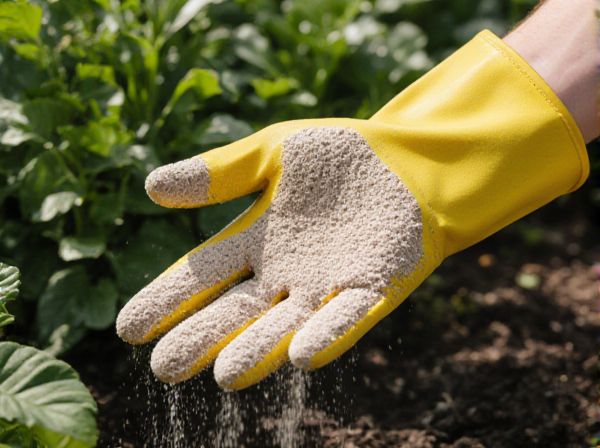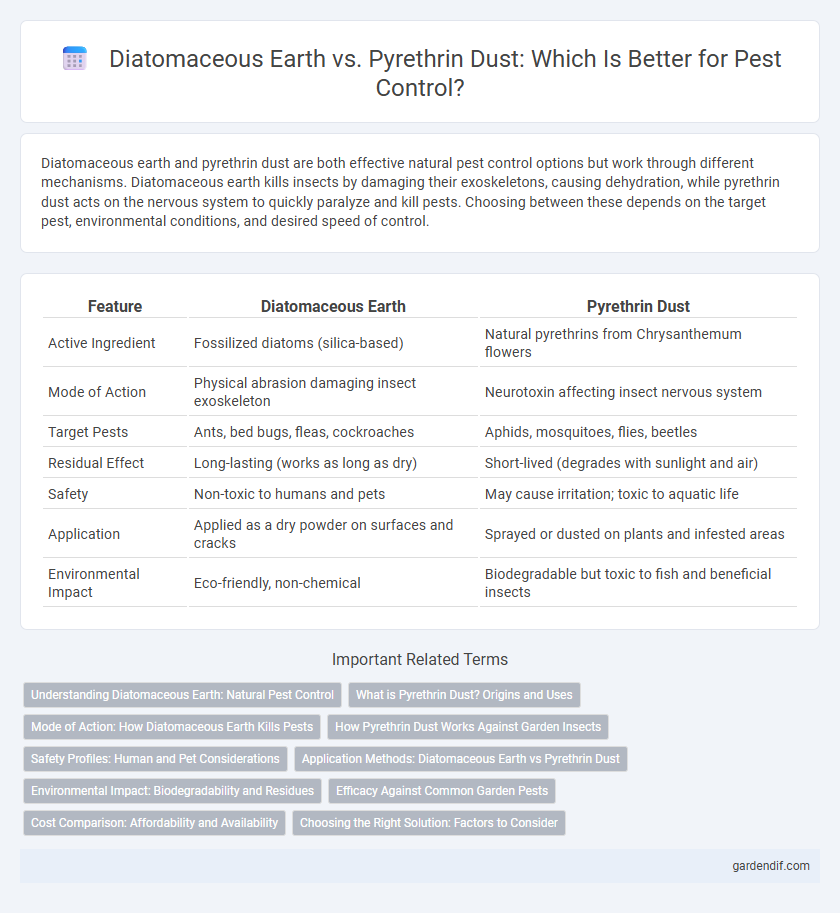
diatomaceous earth vs pyrethrin dust Illustration
Diatomaceous earth and pyrethrin dust are both effective natural pest control options but work through different mechanisms. Diatomaceous earth kills insects by damaging their exoskeletons, causing dehydration, while pyrethrin dust acts on the nervous system to quickly paralyze and kill pests. Choosing between these depends on the target pest, environmental conditions, and desired speed of control.
Table of Comparison
| Feature | Diatomaceous Earth | Pyrethrin Dust |
|---|---|---|
| Active Ingredient | Fossilized diatoms (silica-based) | Natural pyrethrins from Chrysanthemum flowers |
| Mode of Action | Physical abrasion damaging insect exoskeleton | Neurotoxin affecting insect nervous system |
| Target Pests | Ants, bed bugs, fleas, cockroaches | Aphids, mosquitoes, flies, beetles |
| Residual Effect | Long-lasting (works as long as dry) | Short-lived (degrades with sunlight and air) |
| Safety | Non-toxic to humans and pets | May cause irritation; toxic to aquatic life |
| Application | Applied as a dry powder on surfaces and cracks | Sprayed or dusted on plants and infested areas |
| Environmental Impact | Eco-friendly, non-chemical | Biodegradable but toxic to fish and beneficial insects |
Understanding Diatomaceous Earth: Natural Pest Control
Diatomaceous earth is a natural, non-toxic pest control method made from fossilized algae that works by dehydrating insects through abrasive particles. Unlike pyrethrin dust, which is a chemical insecticide derived from chrysanthemum flowers and acts as a neurotoxin, diatomaceous earth provides a physical mechanism to eliminate pests without chemical residues. This makes diatomaceous earth ideal for organic gardening and sensitive environments where chemical exposure must be minimized.
What is Pyrethrin Dust? Origins and Uses
Pyrethrin dust is a natural insecticide derived from the dried flower heads of Chrysanthemum cinerariifolium, widely used for controlling a variety of pests including ants, fleas, and mosquitoes. It works by disrupting insect nervous systems, providing rapid knockdown while being less toxic to mammals and beneficial insects when applied correctly. Commonly used in agriculture, household pest control, and veterinary applications, pyrethrin dust is valued for its biodegradability and effectiveness against resistant insect populations.
Mode of Action: How Diatomaceous Earth Kills Pests
Diatomaceous earth kills pests through a physical mode of action by abrading the waxy outer layer of insect exoskeletons, causing dehydration and eventual death. Unlike pyrethrin dust, which targets the nervous system with neurotoxins, diatomaceous earth acts mechanically without chemical residues or resistance buildup. This makes diatomaceous earth an effective and eco-friendly option for long-term pest control in various environments.
How Pyrethrin Dust Works Against Garden Insects
Pyrethrin dust targets garden insects by disrupting their nervous system, leading to paralysis and death. Derived from chrysanthemum flowers, pyrethrin acts quickly upon contact and breaks down rapidly in sunlight, minimizing environmental impact. Its effectiveness against a wide range of pests makes it a popular choice for organic garden pest control compared to diatomaceous earth.
Safety Profiles: Human and Pet Considerations
Diatomaceous earth is considered safer for humans and pets due to its natural, non-toxic composition, causing mechanical damage to pests rather than chemical poisoning. Pyrethrin dust, derived from chrysanthemum flowers, is effective but can pose risks of allergic reactions or respiratory irritation in sensitive individuals and animals. Proper ventilation and limited exposure are essential when using pyrethrin dust to minimize potential health hazards.
Application Methods: Diatomaceous Earth vs Pyrethrin Dust
Diatomaceous earth is applied as a dry powder that adheres to insect exoskeletons, causing dehydration and death through physical abrasion, making it effective in cracks, crevices, and dry environments. Pyrethrin dust, derived from chrysanthemum flowers, is usually applied as a fine aerosol or dust that provides rapid knockdown of pests by targeting their nervous system, ideal for quick infestations and areas requiring immediate pest control. Both require precise application for maximum efficacy, with diatomaceous earth relying on prolonged contact and pyrethrin dust offering immediate action.
Environmental Impact: Biodegradability and Residues
Diatomaceous earth is highly biodegradable and leaves no harmful chemical residues, making it an environmentally friendly option for pest control. In contrast, pyrethrin dust, derived from chrysanthemum flowers, can degrade relatively quickly but may still leave toxic residues that impact non-target organisms and aquatic ecosystems. Choosing diatomaceous earth minimizes ecological disruption and supports sustainable pest management practices.
Efficacy Against Common Garden Pests
Diatomaceous earth provides a mechanical barrier that dehydrates and kills soft-bodied pests like aphids, ants, and slugs by damaging their exoskeletons, proving highly effective in dry conditions. Pyrethrin dust offers rapid neurotoxic effects against a broad range of garden pests, including beetles, caterpillars, and mites, with fast knockdown and residual action. Both treatments target common insects effectively, but diatomaceous earth excels in slow, persistent control, while pyrethrin dust delivers immediate pest population reduction.
Cost Comparison: Affordability and Availability
Diatomaceous earth is generally more affordable and widely available compared to pyrethrin dust, making it a cost-effective choice for budget-conscious pest control. Pyrethrin dust tends to be more expensive due to its potent insecticidal properties and may be less readily found in local stores. The long shelf life and natural origin of diatomaceous earth also contribute to its economic advantage over pyrethrin dust.
Choosing the Right Solution: Factors to Consider
Choosing between diatomaceous earth and pyrethrin dust depends largely on the target pest species, environmental impact, and safety considerations. Diatomaceous earth offers a non-toxic, physical mode of action ideal for indoor use and organic pest control, while pyrethrin dust provides rapid knockdown with neurotoxic effects suitable for severe infestations but requires caution due to its toxicity to beneficial insects and pets. Effectiveness, application area, and potential health risks should guide the selection to ensure sustainable and safe pest management.
diatomaceous earth vs pyrethrin dust Infographic

 gardendif.com
gardendif.com